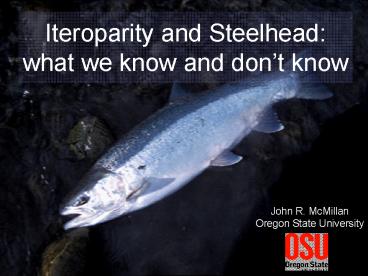Iteroparity and Steelhead: what we know and dont know - PowerPoint PPT Presentation
1 / 14
Title:
Iteroparity and Steelhead: what we know and dont know
Description:
Annual strategy in plants and semelparous strategy in animals. Reproduce one time ... Pacific salmon semelparous (Altukhov et al. 2000) ... – PowerPoint PPT presentation
Number of Views:78
Avg rating:3.0/5.0
Title: Iteroparity and Steelhead: what we know and dont know
1
Iteroparity and Steelhead what we know and dont
know
- John R. McMillan
- Oregon State University
2
Introduction to Reproduction
- Reproductive strategies (big bang v. bet-hedge)
- Annual strategy in plants and semelparous
strategy in animals - Reproduce one time
- Perennial strategy in plants and iteroparous
strategy in animals - Reproduce more than one time
- Salmonid species
- Pacific salmon semelparous (Altukhov et al.
2000) - All other species iteroparous (Wilson 1997)
3
Introduction to Reproduction
- Reproductive strategies (big bang v. bet-hedge)
- Annual strategy in plants and semelparous
strategy in animals - Reproduce one time
- Perennial strategy in plants and iteroparous
strategy in animals - Reproduce more than one time
- Salmonid species
- Pacific salmon semelparous (Altukhov et al.
2000) - All other species iteroparous (Wilson 1997)
4
Selection and Traits
- Life history theory (Stearns 1976 Charlesworth
1994 Crespi and Teo 2002) - Semelparity
- Select for higher juvenile survival
- Increased egg size
- Select for no adult survival
- Increased investment in egg weight, female nest
guarding, secondary sexual characteristics, breed
under higher densities - Iteroparity
- Low or inconsistent juvenile survival
- Smaller egg size
- High adult survival
- Reduced investment in eggs, secondary sexual
characteristics, lower breeding density, and no
female nest guarding
5
Selection and Traits
- Life history theory (Stearns 1976 Charlesworth
1994 Crespi and Teo 2002) - Semelparity
- Select for higher juvenile survival
- Increased egg size
- Select for no adult survival
- Increased investment in egg weight, female nest
guarding, secondary sexual characteristics, breed
under higher densities - Iteroparity
- Select for lower juvenile survival
- Smaller egg size
- Select for higher adult survival
- Reduced investment in egg weight, secondary
sexual characteristics, no female nest guarding,
breed under lower densities
6
Steelhead Patterns
- Steelhead
- One-time reproduction generally most common
- Highly variable rates of repeat spawning (0 79
) - Iteroparous individuals
- Typically female (Burgner et al. 1992 Wertheimer
and Evans 2005) - Typically smaller sized (Teo and Crespi 2002
Hendry and Stearns 2004) - More common in ocean-maturing life history (Busby
et al. 1996) - Latitude and distance from sea
- Highest levels at latitudinal extremes (e.g.,
Russia, Savvaitova et al. 1999 South America,
Riva-Rossi 2007) - Similar observations for Atlantic salmon (Jonsson
and Jonsson 2004) - Perhaps because energy consumption increases with
water temperature - Lowest levels appear to be in furthest inland
populations (Meehan and Bjornn 1991 Narum et al.
2008)
7
Steelhead Patterns
- Steelhead
- One-time reproduction generally most common
- Highly variable rates of repeat spawning (0 79
) - Iteroparous individuals
- Typically female (Burgner et al. 1992 Wertheimer
and Evans 2005) - Typically smaller sized (Teo and Crespi 2002
Hendry and Stearns 2004) - More common in ocean-maturing life history (Busby
et al. 1996) - Latitude and distance from sea
- Highest levels at latitudinal extremes (e.g.,
Russia, Savvaitova et al. 1999 South America,
Riva-Rossi 2007) - Similar observations for Atlantic salmon (Jonsson
and Jonsson 2004) - Lowest levels appear to be in furthest inland
populations (Meehan and Bjornn 1991 Busby et al.
1996 Narum et al. 2008)
8
Latitudinal Distribution of Repeat Spawn Rates
for Steelhead
Derived largely from Busby et al. 1996
Russia
Washington - Oregon
AK - Canada
North
South
9
Why is Iteroparity Important?
- Recruitment
- First-time spawners dont always replace
themselves (e.g., Waddell Creek, Keogh River Hal
Michael, personal communication) - Repeat spawners in Atlantic salmon can produce
disproportionate share of recruitment (Chadwick
1987 Mills 1989)
10
- Fitness
- Increased lifetime fitness
- Greater fecundity
- Repeat spawning female steelhead produced twice
as many offspring as one-time spawners (Seamons
et al., in prep) - Spread risk over multiple generations (Fleming
and Reynolds 2004 Hendry and Stearns 2004)
11
What Human Factors Influence Iteroparity?
- Environment
- Habitat conditions experienced by adults during
return to ocean - Dams
- Climate
- Oversummering habitat in some cases
- Sport and commercial fisheries
- Level of adult exploitation and encounter rates
during return to ocean - Selection against larger fish could select
against iteroparous individuals - This has been suggested to have occurred in
Atlantic salmon (see Jonsson and Jonsson 2004)
12
- Fisheries
- Sport
- Rate of adult exploitation encounter by sport
anglers during return to ocean? - Energy expenditure
- Commercial
- Selection against larger fish could select
against iteroparous individuals - This has been suggested to have occurred in
Atlantic salmon (see Jonsson and Jonsson 2004)
13
Patterns, Processes, Uncertainties
- Lots of hypotheses, little data
- Does iteroparity matter?
- What causes iteroparity?
- Natural v. human influences
- How does this factor into our management regimes?
- Abundance v. diversity
14
(No Transcript)































